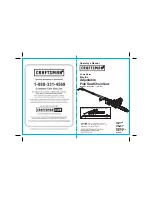
23
22
OPERATION cont.
OPERATION cont.
KICKBACK SAFETY DEVICES ON THIS SAW
(see also pages 10 and 11 for details)
This saw has a low-kickback chain and reduced kickback Guide Bar. Both items reduce
the chance of kickback. However, kickback can still occur with this saw.
The following steps will reduce the risk of kickback.
• Use both hands to grip saw while saw is running. Use firm grip.
Thumbs and fingers must wrap around saw handles.
• Keep all safety items in place on saw. Make sure they work properly.
• Do not overreach or cut above shoulder height.
• Keep solid footing and balance at all times.
• Stand slightly to left side of saw. This keeps your body from being in direct line with chain.
• Do not let Guide Bar nose touch anything when chain is moving.
• Never try cutting through two logs at same time. Only cut one log at a time.
• Do not bury the Guide Bar nose or try plunge cut (boring into wood using Guide Bar nose).
• Watch for shifting of wood or other forces that may pinch chain.
• Use extreme caution when reentering a previous cut.
• Use only the low-kickback chain and Guide Bar
(
9
)
that were supplied with this chain saw.
• Never use a dull or loose chain. Keep chain sharp with proper tension.
CUTTING WOOD UNDER TENSION (See Fig. 17)
INSTRUCTIONS CONCERNING THE PROPER TECHNIQUES FOR BASIC
FELLING, LIMBING, AND CROSS-CUTTING (see Figures A, B, C, D, E and F)
When sawing logs supported on both ends,
start the cut from above (Y) about 1/3 of the
diameter into the log and then finish the cut (Z)
from below, in order to avoid contact of the chain
saw with the ground. When sawing logs supported
on only one end, start the cut from below (Y)
about 1/3 of the diameter into the log and finish
the cut from above (Z) in order to avoid log splitting
or jamming of the chain saw.
1. Felling a tree
When bucking and felling operations are being performed by two or more persons at the
same time, the felling operations should be separated from the bucking operation by a
distance of at least twice the height of the tree being felled. Trees should not be felled in a
manner that would endanger any person, strike any utility line or cause any property damage.
If the tree does make contact with any utility line, the company should be notified immediately.
The chain saw operator should keep on the uphill side of the terrain as the tree is likely to roll
or slide downhill after it is felled.
An escape path should be planned and cleared as necessary before cuts are started.
The escape path should extend back and diagonally to the rear of the expected line of fall
as illustrated in
Figure A. on pg. 24.
Before felling is started, consider the natural lean of the tree, the location of larger branches
and the wind direction to judge which way the tree will fall.
Remove dirt, stones, loose bark, nails, staples and wire from the tree.
2. Notching undercut
Make the notch 1/3 the diameter of the tree, perpendicular to the direction of falls
as illustrated in
Figure A. on pg. 24. Make the lower horizontal notching cut first.
This will help to avoid pinching either the saw chin or the guide bar when the
second notch is being made.
3. Felling back cut
Make the felling back cut at least 50 mm higher than the horizontal notching cut as illustrated
in
Figure A. on pg. 24. Keep the felling back cut parallel to the horizontal notching cut.
Make the felling back cut so enough wood is left to act as a hinge. The hinge wood keeps the
tree from twisting and falling in the wrong direction. Do not cut through the hinge.
HOW TO USE SAW SAFELY
1. Use the chain saw only with secure footing.
2. Hold the chain saw at the right-hand side of your
body (See Fig. 14).
3. The Chain
must be running at full speed before
it makes contact with the wood.
4. Use the Bumper Spikes (8) to secure the
saw onto the wood before starting to cut.
5. Use the Bumper Spikes as a leverage point
while cutting. (See Fig. 15)
6. Do not operate the chain saw with arms fully
extended, attempt to saw areas which are
difficult to reach, or stand on a ladder while
sawing (see Fig. 16).
Elbow
Locked
WARNING:
!
NEVER
REVERSE
HAND
POSITIONS
Fig. 14
8
Fig. 15
Fig. 16
NOTE: Never use the chain saw above shoulder height
WARNING:
When cutting a limb that is under tension, use extreme caution.
Be alert for wood springing back. When wood tension is released, limb could spring
back and strike operator causing severe injury or death.
!
Z
Y
kg
Z
Y
Fig. 17
CUTTING WITH CHAINSAW cont.
CUTTING WITH CHAINSAW cont.



































